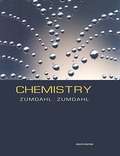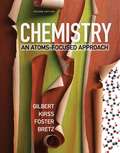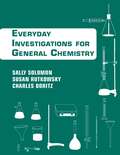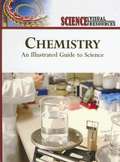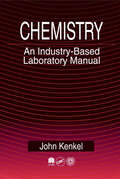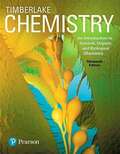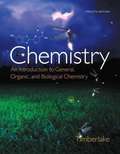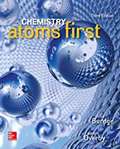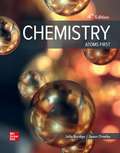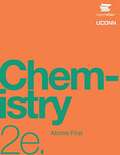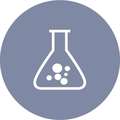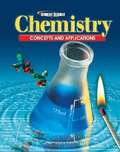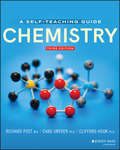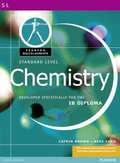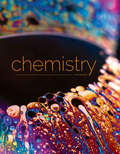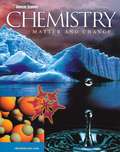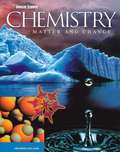- Table View
- List View
Chemistry: Advanced Placement Edition
by Steven S. Zumdahl Susan A. ZumdahlCHEMISTRY allows the reader to learn chemistry basics quickly and easily by emphasizing a thoughtful approach built on problem solving. For the Eighth Edition, authors Steven and Susan Zumdahl have extended this approach by emphasizing problem-solving strategies within the Examples and throughout the text narrative. CHEMISTRY speaks directly to the reader about how to approach and solve chemical problems--to learn to think like a chemist--so that they can apply the process of problem-solving to all aspects of their lives.
Chemistry: An Atoms-focused Approach
by Thomas R. Gilbert Rein V. Kirss Natalie Foster Stacey Lowery BretzThe Second Edition's new co-author, Stacey Lowery Bretz, uses visualization tools--based on Chemistry Education Research, and focused on the particulate nature of matter--to help students self-assess what they know before, during, and after each chapter. Smartwork5 allows instructors to use this pedagogy as a diagnostic, and students receive hints and answer-specific feedback within the text.
Chemistry: An Everyday Approach To Chemical Investigation
by Sally Solomon Susan Rutkowsky Charles BoritzChemistry: An Everyday Approach to Chemical Investigation is intended to accompany any mainstream general chemistry course, and consists of 27 experiments that can be completed using only chemicals found in consumer products. The manual is an ideal resource for courses emphasizing green chemistry in which the use of hazardous materials is reduced or eliminated altogether. Many of the experiments requiring simple equipment and glassware can be performed at remote sites providing laboratory experience for use with on-line or long distance learning courses. The advantages of using accessible materials in chemistry laboratory are considerable. Students can reinforce lecture discussions while working with familiar materials. For instructors, assembling the chemicals required for a lab course can be accomplished with limited budgets and without access to a chemical company. Problems with safety and waste disposal are significantly reduced.
Chemistry: An Illustrated Guide to Science
by Derek McmonagleEach page of the textbook features detailed illustrations and extensive captions, a box of key words that are further explained in the text or in the glossary, and bulleted text that elaborates the topics depicted by the artwork.
Chemistry: An Industry-Based Laboratory Manual
by John KenkelHave you ever had a discussion with an industrial chemist about the job? Have you ever shadowed a chemist or chemical technician in an industrial or government laboratory for a day? If you have done these things, you were likely surprised at how foreign the language seemed or startled at how unfamiliar the surroundings were. Was there any talk of t
Chemistry: An Introduction To General, Organic, And Biological Chemistry
by Karen TimberlakeChemistry: An Introduction to General, Organic, and Biological Chemistry, 13th Edition is the ideal resource for anyone interested in learning about allied health. Assuming no prior knowledge of chemistry, author Karen Timberlake engages readers with her friendly presentation style, revealing connections between the structure and behavior of matter and its role in health and the environment. Aiming to provide a better learning experience, the text highlights the relevance of chemistry through real-world examples. Activities and applications throughout the program couple chemistry concepts with health and environmental career applications to help readers understand why the content matters. The text also fosters development of problem-solving skills, while helping readers visualize and understand concepts through its engaging figures, sample problems, and concept maps. The 13th Edition expands on Karen Timberlake’s main tenets: relevance, a clinical focus, educational research, and learning design. New applications added to questions and problem sets emphasize the material’s relevance, while updated chapter openers with follow-up stories help readers form a basis for making decisions about issues concerning health and the environment. New problem-solving tools in this edition, including Try it First and Connect, urge readers to think critically about problem-solving while learning best practices.
Chemistry: An Introduction to General, Organic, and Biological Chemistry (12th Edition)
by Karen C. TimberlakeFor one-semester courses in General, Organic, and Biological Chemistry Show the importance of chemistry in the real world Chemistry: An Introduction to General, Organic, and Biological Chemistry, Twelfth Edition is the ideal resource for today's allied health students. Assuming no prior knowledge of chemistry, author Karen Timberlake engages students through her friendly presentation style and reveals connections between the structure and behavior of matter and its role in health and the environment.
Chemistry: Atoms First
by Richard Langley Edward J. Neth Pau Flowers Klaus Theopold William R. RobinsonOFFICIAL PRINT VERSION: OpenStax OER official printed textbooks, published by XanEdu Publishing (XanEdu is OpenStax official print provider), ships from and sold by Amazon.com ABOUT THIS BOOK: This is the most affordable printed OpenStax book available. As an OpenStax Partner we print all OpenStax textbooks with a unique soft cover and BW interior pages. The textbook content is exactly the same as the free digital OpenStax book (Digital ISBN\-13: 978\-1\-947172\-18\-0). This textbook is available for free download at the OpenStax website, but as many students prefer the convenience of a printed book, we offer this book in partnership with OpenStax to provide an affordable printed option for college students. BOOK SUMMARY: Chemistry: Atoms First is a peer\-reviewed, openly licensed introductory textbook produced through a collaborative publishing partnership between OpenStax and the University of Connecticut and UConn Undergraduate Student Government Association. This title is an adaptation of the OpenStax Chemistry text and covers scope and sequence requirements of the two\-semester general chemistry course. Reordered to fit an atoms first approach, this title introduces atomic and molecular structure much earlier than the traditional approach, delaying the introduction of more abstract material so students have time to acclimate to the study of chemistry. Chemistry: Atoms First also provides a basis for understanding the application of quantitative principles to the chemistry that underlies the entire course. ABOUT OPENSTAX: OpenStax course materials are the most widely used OER textbooks in the world. Always free in digital format, the books are also available low cost in full\-color hardcover and B\x26W paperback print formats.
Chemistry: Atoms First
by Julia Burdge Jason OverbyThe Atoms First approach provides a consistent and logical method for teaching general chemistry. This approach starts with the fundamental building block of matter, the atom, and uses it as the stepping stone to understanding more complex chemistry topics. Once mastery of the nature of atoms and electrons is achieved, the formation and properties of compounds are developed. Only after the study of matter and the atom will students have sufficient background to fully engage in topics such as stoichiometry, kinetics, equilibrium, and thermodynamics. Thus, the Atoms First approach empowers instructors to present the most complete and compelling story of general chemistry. Far from a simple re-ordering of topics, this is a book that will truly meet the needs of the growing atoms-first market. The third edition continues to build on the innovative success of the first and second editions. Changes to this edition include specific refinements intended to augment the student-centered pedagogical features that continue to make this book effective and popular both with professors, and with their students.
Chemistry: Atoms First
by Julia Burdge Jason OverbyThe fourth edition of Chemistry: Atoms First by Burdge and Overby builds further on the success of the first three editions. Changes to this edition focus on new additions to the pedagogy, refinement of the current approach, and other innovations driven by feedback from instructors and students alike.
Chemistry: Atoms First
by OpenStaxChemistry: Atoms First 2e is a peer-reviewed, openly licensed introductory textbook produced through a collaborative publishing partnership between OpenStax and the University of Connecticut and UConn Undergraduate Student Government Association. This text is an atoms-first adaptation of OpenStax Chemistry 2e. The intention of “atoms-first” involves a few basic principles: first, it introduces atomic and molecular structure much earlier than the traditional approach, and it threads these themes through subsequent chapters. This approach may be chosen as a way to delay the introduction of material such as stoichiometry that students traditionally find abstract and difficult, thereby allowing students time to acclimate their study skills to chemistry. Additionally, it gives students a basis for understanding the application of quantitative principles to the chemistry that underlies the entire course. It also aims to center the study of chemistry on the atomic foundation that many will expand upon in a later course covering organic chemistry, easing that transition when the time arrives. The second edition has been revised to incorporate clearer, more current, and more dynamic explanations, while maintaining the same organization as the first edition. Substantial improvements have been made in the figures, illustrations, and example exercises that support the text narrative.
Chemistry: Bullet Guides
by Helen HardenOpen this book and you will- Make sense of the elements- Grasp critical concepts- Fill gaps in your knowledge- Pass Chemistry!
Chemistry: Concepts And Applications
by Mcgraw-Hill StaffChemistry: Concepts and Applications is a conceptual approach to the presentation of chemistry. It has a clear and comprehensive narrative of chemistry concepts with just the right amount of math. Two of many in-text lab options include Launch Labs and Try at Home Labs, the latter of which are unique to Glencoe. The program's media/technology support diverse classroom instruction.
Chemistry: Concepts and Applications
by Cheryl Wistrom John S. Phillips Victor S. StrozakChemistry: Concepts and Applications is a conceptual approach to the presentation of chemistry. It has a clear and comprehensive narrative of chemistry concepts with just the right amount of math.
Chemistry: Concepts and Applications
by Mcgraw-Hill StaffChemistry: Concepts and Applications is a conceptual approach to the presentation of chemistry. It has a clear and comprehensive narrative of chemistry concepts with just the right amount of math. Two of many in-text lab options include Launch Labs and Try at Home Labs, the latter of which are unique to Glencoe. The program's media/technology support diverse classroom instruction.
Chemistry: Concepts and Problems, A Self-Teaching Guide (Wiley Self-Teaching Guides #166)
by Richard Post Chad Snyder Clifford C. HoukTHE QUICK AND PAINLESS WAY TO TEACH YOURSELF BASIC CHEMISTRY CONCEPTS AND TERMS Chemistry: A Self-Teaching Guide is the easy way to gain a solid understanding of the essential science of chemistry. Assuming no background knowledge of the subject, this clear and accessible guide covers the central concepts and key definitions of this fundamental science, from the basic structure of the atom to chemical equations. An innovative self-guided approach enables you to move through the material at your own pace—gradually building upon your knowledge while you strengthen your critical thinking and problem-solving skills. This edition features new and revised content throughout, including a new chapter on organic chemistry, designed to dramatically increase how fast you learn and how much you retain. This powerful learning resource features: An interactive, step-by-step method proven to increase your understanding of the fundamental concepts of chemistry Learning objectives, practice questions, study problems, and a self-review test in every chapter to reinforce your learning An emphasis on practical concepts and clear explanations to ensure that you comprehend the material quickly Engaging end-of-chapter stories connecting the material to a relevant topic in chemistry to bring important concepts to life Concise, student-friendly chapters describing major chemistry concepts and terms, including the periodic table, atomic weights, chemical bonding, solutions, gases, solids, and liquids Chemistry: A Self-Teaching Guide is an ideal resource for high school or college students taking introductory chemistry courses, for students taking higher level courses needing to refresh their knowledge, and for those preparing for standardized chemistry and medical career admission tests.
Chemistry: Developed Specifically for the IB Diploma
by Mike Ford Catrin BrownThis book is designed to act as a comprehensive course book, covering both the core material and all the options you might take while studying for the IB Diploma in Chemistry at Standard Level. It will also help you to prepare for your examinations in a thorough and methodical way.
Chemistry: Energy, Matter, and Change
by William B. TuckerProviding a holistic overview of general chemistry and its foundational principles, this textbook is an essential accompaniment to students entering the field. It is designed with the reader in mind, presenting the historical development of ideas to frame and center new concepts as well as providing primary and summative sources for all topics covered. These sources help to provide definitive information for the reader, ensuring that all information is peer-reviewed and thoroughly tested.Features: The development of key ideas is presented in their historical context All information presented is supported through citations to chemical literature Problems are incorporated throughout the text and full, worked-out solutions are presented for every problem International Union of Pure and Applied Chemistry style and technical guidelines are followed throughout the text The problems, text, and presentation are based on years of classroom refinement of teaching pedagogy This textbook is aimed at an advanced high school or general college audience, aiming to engage students more directly in the work of chemistry.William Tucker’s passion for chemistry was inspired by his high school teacher Gary Osborn. He left Maine to pursue Chemistry at Middlebury College, and after graduating in 2010 he decided to pursue a PhD in Organic Chemistry at the University of Wisconsin-Madison. At the University of Wisconsin-Madison, he worked in the laboratory of Dr. Sandro Mecozzi, where he developed semifluorinated triphilic surfactants for hydrophobic drug delivery. After earning his PhD in 2015, he took a fellowship at Boston University as a Postdoctoral Faculty Fellow. There he co-taught organic chemistry while working in the laboratory of Dr. John Caradonna. In the Caradonna l boratory, he worked on developing a surface-immobilized iron-oxidation catalyst for the oxidation of C–H bonds using dioxygen from the air as the terminal oxidant. Throughout all of this work, his passion has always been for teaching and working with students both in and out of the classroom. He has been lucky for the past six years to work at Concord Academy, where his students have, through their questions, pushed him to think deeper and more critically about chemistry. Their curiosity inspires him, and their inquisitiveness inspired his writing.
Chemistry: Grade 11, Student Edition
by Bju PressThe student edition moves the student from of the definition of matter to how matter interacts in chemical reactions, solutions, acids and bases, organic chemistry, biochemistry, and nuclear changes. It helps students understand the macroscopic effects of chemical changes that they can see, but also the unseen microscopic changes that are the actual chemistry. Through this book the student will learn an appreciation of the modeling nature of chemistry.
Chemistry: Matter & Change
by Thandi Buthelezi Laurel Dingrando Nicholas HainenGlencoe Chemistry: Matter and Change © 2008 combines the elements students need to succeed! A comprehensive course of study designed for a first-year high school chemistry curriculum, this program incorporates features for strong math support and problem-solving development. New features for 2008 include content organized around Themes, Big Ideas, and Main Ideas, promoting student comprehension and testing success; more assessment options than ever; Dinah Zike's FOLDABLES, three-dimensional graphic organizers that help students grasp information for review and retention; the latest in Glencoe classroom technology, and much more!
Chemistry: Matter and Change
by Dinah Zike Thandi Buthelezi Laurel Dingrando Nicholas Hainen Cheryl WistromNIMAC-sourced textbook
Chemistry: Matter and Change
by Laurel Dingrando Nicholas Hainen Cheryl Wistrom Kathleen V. GreggChemistry: Matter and Change is a comprehensive chemistry course of study, designed for a first year high school chemistry curriculum. The program incorporates features for strong math-skill development.
Chemistry: Matter and Change
by Laurel Dingrando Nicholas Hainen Cheryl Wistrom Kathleen Gregg TallmanChemistry: Matter and Change is a comprehensive chemistry course of study designed for a first-year high school chemistry curriculum. The program incorporates features for strong math support and problem-solving development. The content has been reviewed for accuracy and significant enhancements have been made to provide a variety of interactive student- and teacher-driven technology support.
Chemistry: Matter and Change
by Dinah Zike Thandi Buthelezi Laurel Dingrando Nicholas Hainen Cheryl WistromGlencoe Chemistry: Matter and Change© 2008 combines the elements students need to succeed! A comprehensive course of study designed for a first-year high school chemistry curriculum, this program incorporates features for strong math support and problem-solving development. New features for 2008 include content organized around Themes, Big Ideas, and Main Ideas, promoting student comprehension and testing success; more assessment options than ever; Dinah Zike's FOLDABLES, three-dimensional graphic organizers that help students grasp information for review and retention; the latest in Glencoe classroom technology, and much more!
